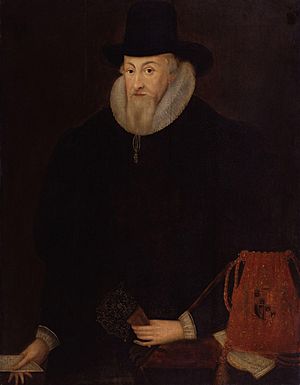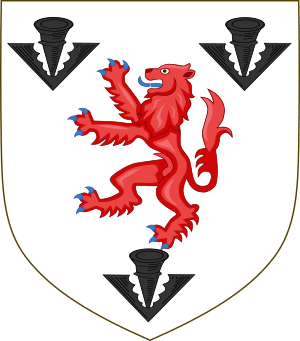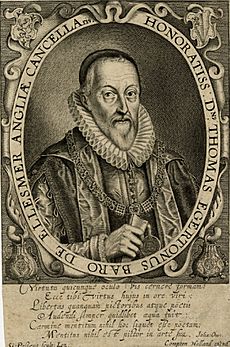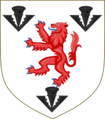Thomas Egerton, 1st Viscount Brackley facts for kids
Quick facts for kids
The Viscount Brackley
|
|||||||||||||||||||||||||||
|---|---|---|---|---|---|---|---|---|---|---|---|---|---|---|---|---|---|---|---|---|---|---|---|---|---|---|---|

Thomas Egerton, 1st Viscount Brackley, National Portrait Gallery, London
|
|||||||||||||||||||||||||||
| Lord High Treasurer | |||||||||||||||||||||||||||
| In office 1613–1614 |
|||||||||||||||||||||||||||
| Preceded by | The Earl of Northampton | ||||||||||||||||||||||||||
| Succeeded by | The Earl of Suffolk | ||||||||||||||||||||||||||
| Lord High Chancellor of England | |||||||||||||||||||||||||||
| In office 6 May 1596 – 5 March 1617 |
|||||||||||||||||||||||||||
| Preceded by | Sir John Puckering | ||||||||||||||||||||||||||
| Succeeded by | Sir Francis Bacon | ||||||||||||||||||||||||||
| Lord Keeper of the Great Seal | |||||||||||||||||||||||||||
| In office 6 May 1596 – 5 March 1617 |
|||||||||||||||||||||||||||
| Preceded by | Sir John Puckering | ||||||||||||||||||||||||||
| Succeeded by | Sir Francis Bacon | ||||||||||||||||||||||||||
|
|||||||||||||||||||||||||||
| Personal details | |||||||||||||||||||||||||||
| Born | (c.1540) Dodleston, Cheshire, England |
||||||||||||||||||||||||||
| Died | 15 March 1617 | ||||||||||||||||||||||||||
| Spouse | Elizabeth Ravenscroft | ||||||||||||||||||||||||||
| Children | Sir Thomas Egerton John Egerton, 1st Earl of Bridgwater Mary Egerton |
||||||||||||||||||||||||||
| Parents | Sir Richard Egerton Alice Sparks |
||||||||||||||||||||||||||
Thomas Egerton, 1st Viscount Brackley, born around 1540, was an important English nobleman, judge, and statesman. He died on March 15, 1617. For many years, he was known as Lord Ellesmere. He held very important jobs like Lord Keeper and Lord Chancellor for over two decades. He was a key figure in England's government and legal system during the reigns of Queen Elizabeth I and King James I.
Contents
Early Life and Education
Thomas Egerton was born in 1540 in Dodleston, a town in Cheshire, England. His father was Sir Richard Egerton. Even though his parents were not married, his father's family supported him. They made sure he received a good education.
He went to Brasenose College at the University of Oxford to study Liberal Arts. He earned his bachelor's degree in 1559. After that, he studied law at Lincoln's Inn, which is a place where lawyers are trained. By 1572, he became a barrister, which means he could argue cases in court.
Starting His Legal Career
Egerton became a respected lawyer. He argued cases in important courts like the Queen's Bench and the Court of Chancery. Queen Elizabeth I herself noticed his skills after watching him argue a case against the Crown. Because of his talent, she appointed him as a Queen's Counsel. This meant he was a top lawyer who advised the Queen.
In 1579, he was chosen to be a Master of the Bench at Lincoln's Inn. This was a leadership role within the legal society. On June 28, 1581, he was appointed Solicitor General. This was another important legal position for the Crown.
Family Life
Thomas Egerton married Elizabeth Ravenscroft in 1576. They had three children together:
After Elizabeth died, Egerton married Elizabeth Wolley. She was the widow of Sir John Wolley. Later, Elizabeth also passed away. Egerton then married Alice Spencer, who was a patron of the arts. She outlived him by twenty years.
Key Roles in Government
As Solicitor General, Egerton often argued important cases for the Queen. He even took on cases that the Attorney General would normally handle. From 1584 to 1587, he also served as a Member of Parliament for Cheshire.
He was involved in some very famous trials. In 1586, he was one of the lawyers who prosecuted Mary, Queen of Scots. He also prosecuted Philip Howard, Earl of Arundel, for treason.
On June 2, 1592, he became the Attorney General. He was knighted the next year, becoming Sir Thomas Egerton. He then became Master of the Rolls on April 10, 1594. In this role, he was an excellent judge and supported younger lawyers like Francis Bacon.
After the Lord Keeper, John Puckering, died, Egerton was appointed Lord Keeper of the Great Seal on May 6, 1596. He also became a Privy Councillor. He continued to be the Master of the Rolls, making him the main judge in the Court of Chancery.
Lord Keeper and Lord Chancellor
As Lord Keeper, Egerton's decisions were highly respected. However, some common-law judges were not happy because he often overturned their rulings. He also tried to expand the power of the Court of Chancery. In Parliament, he supported legal reforms and the Queen's power to create monopolies.
Sir Thomas Egerton was a friend of Robert Devereux, 2nd Earl of Essex. He often tried to help improve the relationship between Essex and the Queen. When Essex returned from Ireland in disgrace, he was placed under house arrest at Egerton's home. Egerton was one of the judges at Essex's first trial. He tried to convince Essex to apologize to the Queen.
During Essex's rebellion, Egerton was sent to persuade Essex to give up. However, he was held hostage for several hours until one of Essex's supporters freed him.
When James VI of Scotland became King James I of England, Egerton remained in his important role. King James made him Lord Chancellor and the 1st Baron Ellesmere on July 19, 1603. He was no longer Master of the Rolls, but he still helped with those duties. Soon after, he oversaw the trial of Barons Cobham and Grey de Wilton for treason.
In the first Parliament of King James I, Lord Ellesmere tried to use the Lord Chancellor's right to remove members from the House of Commons. However, he eventually gave this right to the House itself. He also tried to convince Parliament to support the King's idea of uniting England and Scotland, but he was not successful. In 1606, he ruled that Scottish people born after King James I became king were considered English subjects.
Lord Ellesmere supported the King's special powers, known as the Royal Prerogative. However, he wanted to make sure these powers were clearly defined and not confused with regular legal processes. Towards the end of his life, he disagreed with Sir Edward Coke, the Lord Chief Justice. Egerton helped the King remove Coke from his position.
Egerton tried to resign several times because he was getting old and sick. The King finally accepted his resignation on March 5, 1617. Before he left office, he was given the title of Viscount Brackley on November 7, 1616. He was also promised the title of Earl of Bridgwater, but he was not very interested. He died twelve days after leaving office, on March 15, 1617. He is buried in Dodleston, Cheshire.
Images for kids
-
Thomas Egerton, 1st Viscount Brackley, National Portrait Gallery, London
-
Engraved portrait of Thomas Egerton by Simon de Passe






